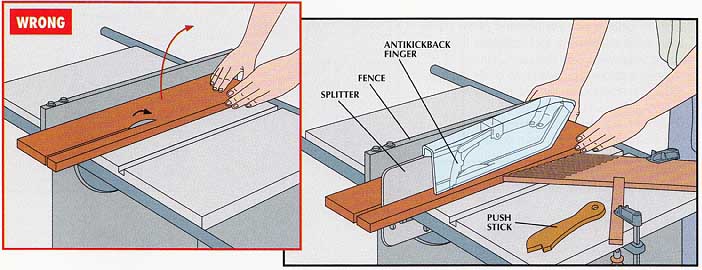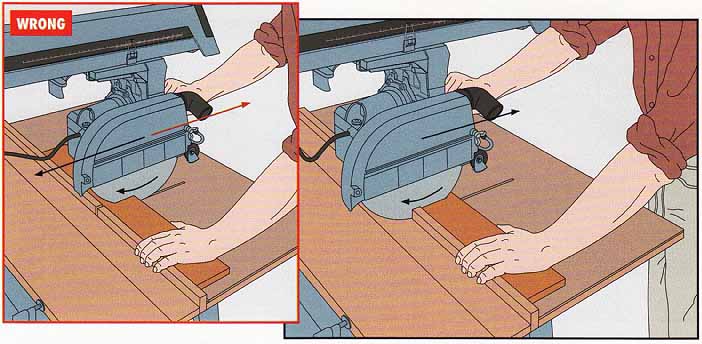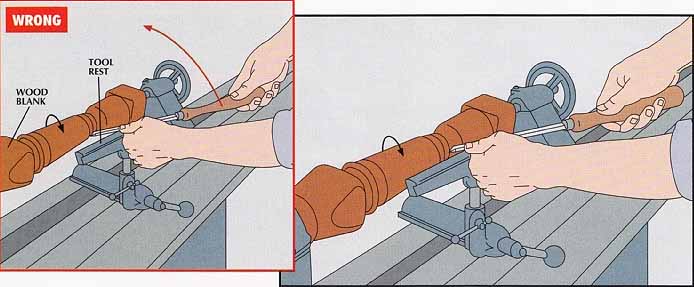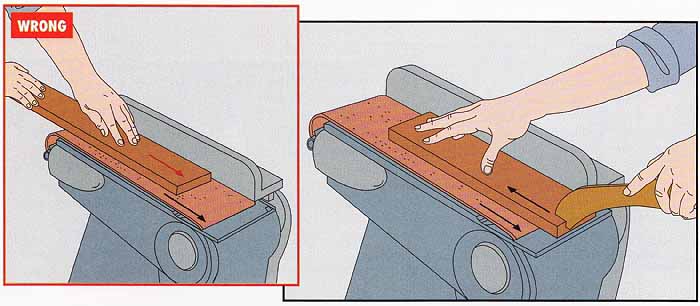Tool safety is built on a foundation of caution, vigilance, and safe work habits. This precept does not only apply to novices—injuries can occur as you become more skilled if you take shortcuts and grow careless.
Know Your Machine: Carefully read the manuals that come with your power tools so you can operate them correctly. Keep tools properly adjusted and lubricated, and blades sharp. Dull blades make you force the work through the machine, which is dangerous. Unplug a machine when changing accessories or making major adjustments. Get into the habit of using safety aids. Leave guards, shields, and anti- kickback devices in place. If an operation makes it impossible to use them, exercise extreme caution. Use push sticks and hold-down blocks to feed and secure workpieces so your hands never come closer than 3 inches to a moving blade or sanding belt.
Electrical Safely: To avoid shocks, make sure your tools are properly grounded, and check electrical connections frequently for exposed or loose wires. Never stand on a wet surface while operating a power tool; keep the cord away from moving blades, belts, wheels, and spinning shafts.
Safety Gear: Wear a face shield when using a lathe or grinding wheel; add a dust mask when you operate a belt or orbital sander. Use earplugs to protect your hearing. Avoid loose clothing that could catch in moving parts; tie back long hair.
Stop working when you are tired — fatigue is responsible for many accidents in a home workshop.
PREVENTING SHOP ACCIDENTS
The kickback of a table saw can throw a piece of lumber with violence (above, left). To pre vent kickback, cut flat wood only. If you are ripping, the board requires a straight edge to ride along the rip fence. Most table-saw blade guards are equipped with a splitter and anti- kickback fingers; feather-boards also significantly reduce the risk of kickback by keeping the workpiece pressed against the table and rip fence. Mounted on the fence, hold-down devices have rubber wheels that keep a workpiece firmly against the table; to prevent kickback, the wheels lock when pushed against the direction of cut, keeping the board from shooting backward. To rip a board, hold it down and push it against the fence with your left hand while your right hand—straddling the fence—moves it forward (above, right). Continue to feed the workpiece past the blade with a push stick to keep fingers at least 3 inches away from blade.
To prevent self-feeding, install the correct blade. If you push the blade through the wood you risk kickback, which will cause the saw to lurch toward you (above, left). Instead, pull the saw through the workpiece (above, right). After the cut, slide the blade back behind the fence. To make a rip cut, turn the blade parallel to the fence and lock it in position; then feed the wood into the blade, using hold-downs and anti- kickback fingers to secure it. Feed the work- piece with a push stick once your fingers are within 6 inches of the blade.
The spinning bit of a drill press can twist the workpiece right out of your hands (above, left). To prevent this, brace the work against the machine’s vertical back column, or anchor it with clamps at the table edges (above, right); always clamp small workpieces.
If the tool rest is too far away from the work- piece, the chisel or gouge can easily be grabbed by the wood. The tool will invariably dig into the wood and, if the tool is extended far enough, it could be flipped upward (above, left). To prevent this, keep the tool rest about inch away from the workpiece, moving it closer as the blank is reduced in diameter (above, right). When roughing out a square blank, start at a slow speed. For any turning operation, hold the tool so its bevel is rubbing against the wood, then pivot it up to engage the cutting edge.
If you feed a board onto the belt in the same direction as its rotation (above, left), the sander can rip the board out of your hands and launch it at great speed, exposing your hands to the spinning sandpaper. Instead, feed the wood against the direction of the belt’s rotation and protect the hand pushing the work from the belt by using a push stick (above, right).
If the workpiece is not kept against the table and fence, the bit can grab it and throw it back at you. If you feed the wood into the bit in its direction of rotation, the wood—and your hand—may be pulled toward the bit (above, left). To eliminate these risks, clamp a pair of feather-boards to the fence and table. Feed the wood into the bit against the bit’s direction of rotation (above, right), and guide the end of the piece past the bit with a push stick.
When smoothing a board face on the jointer—known as face-jointing—the blades of the tool can grab the end of a small or improperly guided board and pull it—and possibly your hand—into the machine (above, left). Avoid jointer jump by face-jointing wood no thinner than inch and no less than 12 inches long. Set the depth of cut to a maximum of inch to help prevent kickback. Always use the spring guard over the blades; it has been omitted here for the sake of clarity. Keep the wood flat against the table with a push block, and distance your fingers from the blades with a push stick (above, right).
Next: Laying Out the
Shop
Prev: Stationary Power Tools






